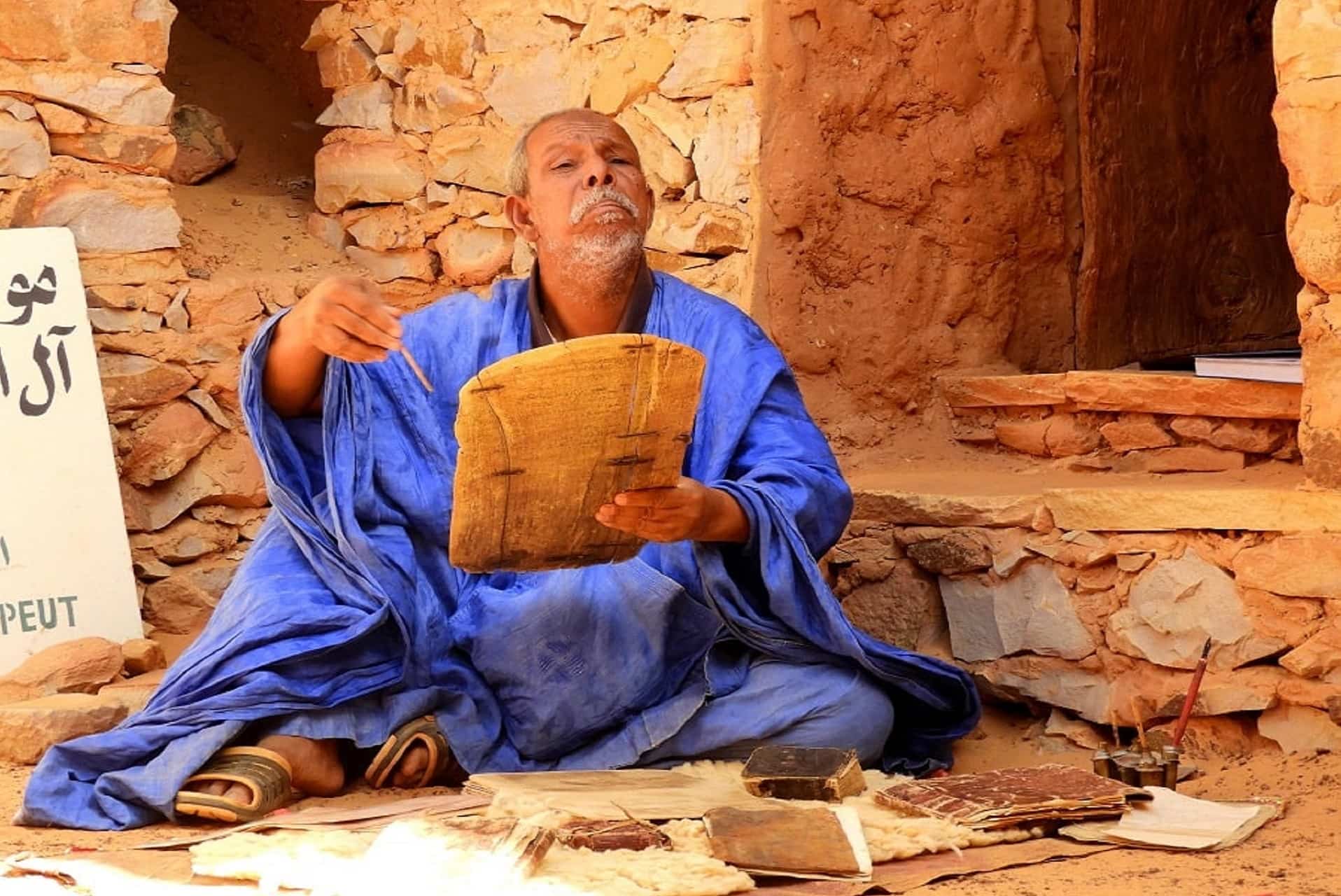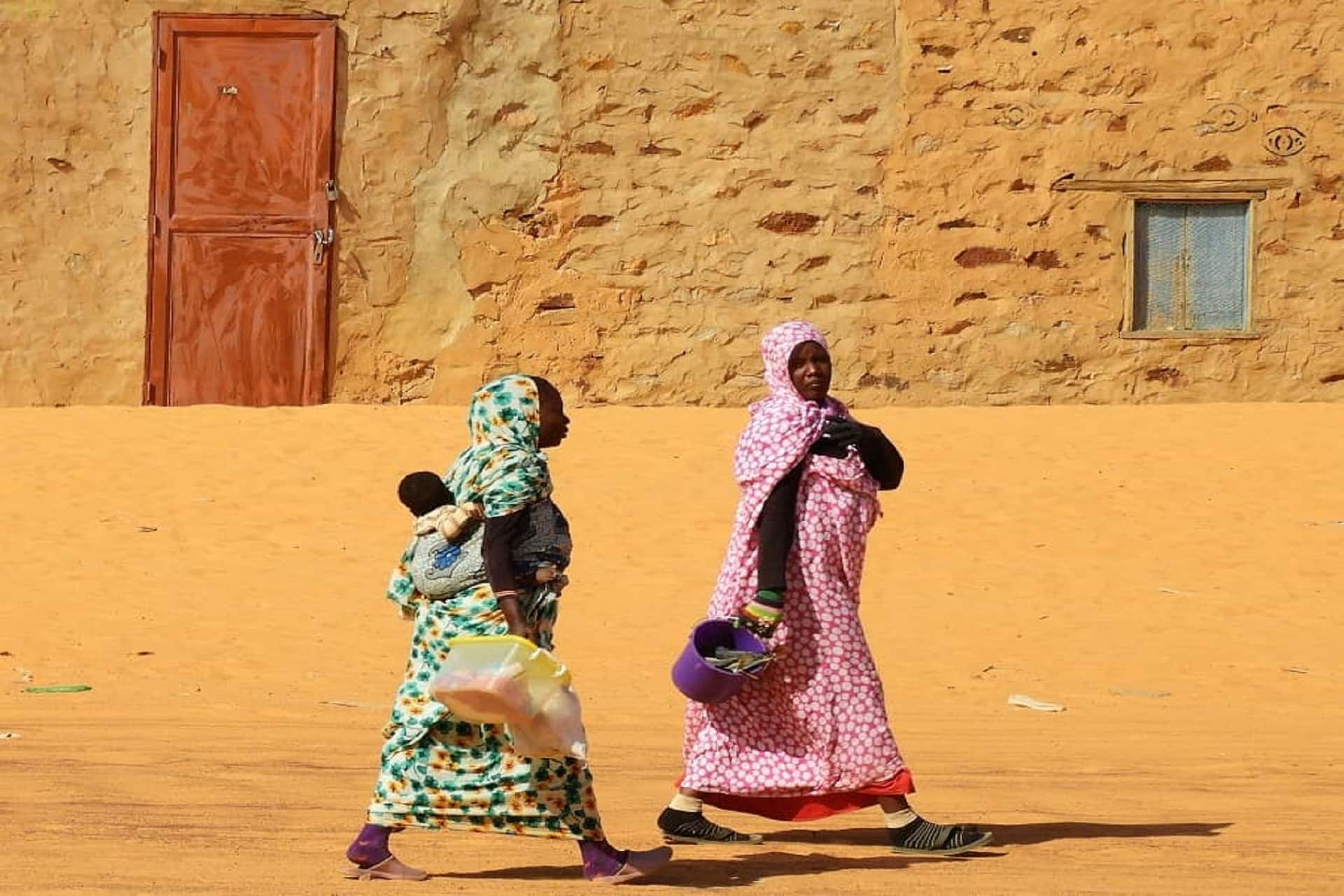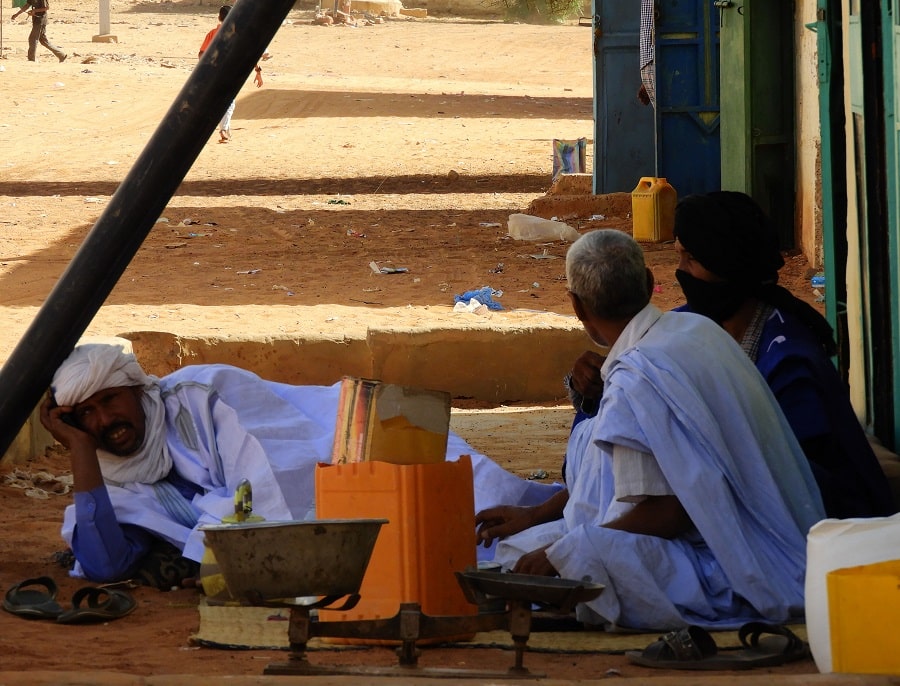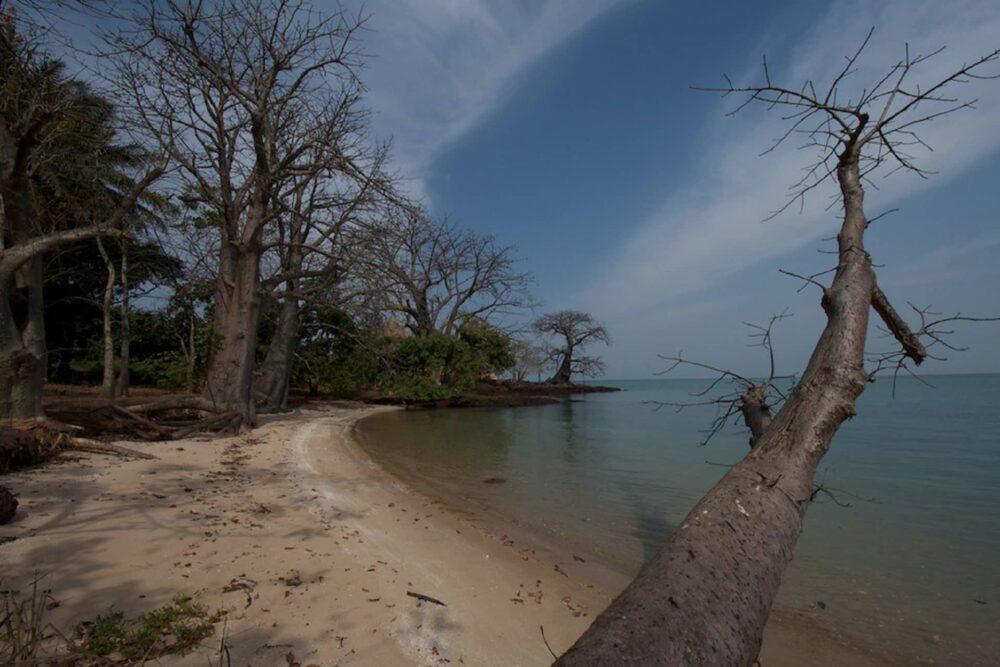Description
MAURITANIA
21 days: mountains, oasis, rock art, African frescoes on the way to the oldest empire in black Africa. Experience a true exploration of the Sahara, out of the beaten track; retrace an ancient caravan route through the largest desert on earth.

A new exploratory expedition through Mauritania, an itinerary that is the result of many years of research in this part of the Sahara. The itinerary begins in Nouakchott, the capital, and soon we will travel along the main road through spectacular dune ranges. In the Adrar massif, surrounded by yellow sand, we will encounter nomad encampments and make a stop while drinking tea with them. In a universe of absolute aridity, we will discover lush oases hidden in canyons, palm-shaded gardens and typical adobe villages, huts and conical grass roofs.
Chinguetti has a magical atmosphere, one of the most well conserved oases in the whole Sahara. The ancient stone village dates to the thirteenth century, when Chinguetti was the seventh holiest city of Islam and the main caravan terminal in the western regions of Sahara. In the old quarter of the city, the Ksar, is a white stone mosque whose minaret is considered the second oldest still in operation in the world, a remarkable example of Arab-Berber stone architecture.
We visit two ancient manuscript collections, the largest and the one held by a descendant of the family that has been collecting ancient Arabic manuscripts for centuries.
Ouadane was founded ‘only’ in 1147. It is the most remote oasis in Mauritania and the western outpost before the total vacuum…. Where we will continue.
Guelb er Richat is called the ‘Eye of Africa’ by geologists: a geological mystery, a series of three concentric rock circles, the largest of which is 40 kilometers (25 miles) in diameter.
The rarely visited El Ghallaouiya canyon is home to more than six hundred graffitied figures, warriors, horse-drawn chariots, hunters, wild animals and more, a unique “open-air gallery” that takes us back thousands of years, to the time before desertification, when the Sahara was a green savannah. From the abandoned colonial fort of El Ghallaouiya the real exploration begins beyond the horizon, hundreds of kilometers of virgin sand and continuous chains of dunes.
We will sail along the immensity of Erg Ouarane. The only human traces we will be able to find in the coming days will be prehistoric stone tools, silent testimonies of people who lived there thousands of years ago. A unique experience in the immensity, for days our direction will be decided only by the experience of our guides and the fictitious points of the GPS.
Aoukar, a series of escarpments creates a spectacular landscape of dark mountains. The range divides the great Ouarane dunes in the north from the Aoukar depression in the south. We will join an 11th-century caravan route connecting Oualata with the western part of Mauritania to discover Maghrouga, one of the most spectacular rock erosions in the Sahara: nature has sculpted a rocky massif in the shape of an elephant. Some graffiti depicting an archaic Berber alphabet (Tifinag) testify to an ancient human presence.
Following the caravan route, we arrive in Oualata, a World Heritage Site and unique for the traditional frescoes that decorate the facades of the adobe houses. The colorful arabesques and geometric patterns made exclusively by women make Oualata a unique oasis.
A remote trail takes us to the archaeological site of Aoudaghost, with miles of ruins hidden by the mountains. Aoudaghost was the northern city of the Ghana Empire, the oldest known empire in black Africa, dating back to the 6th century. It was a rich trading center, where caravan merchants from North Africa bought gold dust. Arab chroniclers described Aoudaghost in manuscripts as beautiful as Mecca.
We explore cobbled alleys and the remains of stone buildings. Only a few sites in Aoudaghost were studied by French archaeologists in the early 1960s, but today all traces of the excavations have been covered by sand and have disappeared, and we will have the impression that we are the first to visit the site after a thousand years of silence. We leave Aoudaghost to discover Dogba, a large and even more mysterious stone city that has not yet been studied or excavated.
We will explore the western part of the Aoukar basin. Mauritanian guides say that only experienced camel guides can venture into these remote regions; TransAfrica’s guides and leaders are also experienced caravanners… We will leave the region by ‘climbing’ with our mechanical caravan the Foum el Nega (the Nega Pass) considered the most difficult passage of what was once the Paris-Dakar rally in Africa.
After successfully crossing the steep and sandy pass, in a route that is absolutely out of the way, we will join the Matmata guelta. In the meagre waters of this guelta, we discover some ‘living fossils’ that have managed to survive the most dramatic of climatic changes that have transformed a green savannah crossed by rivers into today’s Sahara: the rare Desert Crocodile (Crocodylus Suchus), which still survives in the Mauritanian and Chadian desert.
The Crocodylus Suchus lives mainly on fish and has adapted to survive the Sahara’s long dry season through aestivation, something similar to hibernation, but not to survive a cold and snowy winter, but to survive the hot and dry summer season by reducing metabolism and all vital activities, falling into a sleep-like state. In these regions we will be the first travellers to explore some previously undiscovered archaeological sites with remains of large fortified stone citadels that TransAfrica discovered in a recent exploration.
Day 1: ARRIVAL IN MAURITANIA
Arrival in Nouakchott. Transfer and overnight stay at hotel.
Day 2: NOUAKCHOTT
As resume of Mauritanian history and culture, visit of the interesting National Museum which displays archeology, artifacts, costumes, and textiles from prehistory to the present days. Unique pictures taken during excavations of Aoudaghost, the northern trading town and better conserved site of the legendary Ghana Empire, that we will get in touch with on day 16th. Lunch in a restaurant managed by Ivorian women to taste their specialties. Afternoon driving along the northbound road in the Sahara Desert in a spectacular dune landscape to the mining town of Akjoujt.
Day 3: ADRAR: DUNES AND MOUNTAINS
Early departure for an intense day visiting the even more scenic landscape of Mauritania: valleys, high mountains, yellow sand with dark brown and red rock peaks, remote adobe villages.
The Amatlich Erg is one of the most beautiful dune chains in the region. We will visit remote nomadic camps, oases and hidden adobe villages finding here and there prehistoric stone arrowheads, a fragment of terracotta: silent testimony of peoples who lived in these sites a long time ago, before desertification).
These human encounters after the immense silence of the Sahara are intense.
Evening arrival in Chinguetti.
Day 4: CHINGUETTI, THE OASIS
Chinguetti is an ancient caravan terminal and an important trading point between North and Black Africa. The stone village, at a cross point of different caravan routes, dates back to the thirteenth century and is reckoned nowadays as the jewel of the Mauritanian oases.
We will spend the whole day in the magical atmosphere of this citadel, discovering among others, palm groves that shade vegetable gardens, a green miracle. In the old stone quarters, we will be invited to visit two ancient manuscript collections, including Ould Habott, the largest one in Mauritania. The white stone mosque considered the second ancient, still operating in the world. As remains of the colonial: the former French Foreign Legion fort and the tribunal building in Neo-Sudanese style.
The day will end on the highest dunes to enjoy the sunset over Chinguetti.
Return to our cozy base.
Day 5: OUADANE, THE REMOTEST
Drive to Ouadane.
Ouadane, founded in 1147 on a rocky hill, is the most remote oasis in Mauritania, an outpost facing the immensity of the desert. Mainly in ruins, some of its stone houses are still inhabited. In ancient times, Ouadane was a caravan trading point between the Maghreb and black Africa. Trade was so flourishing that in 1487 the Portuguese built a fortified trading post in the region.
Day 6: THE EYE OF AFRICA
Guelb er Richat, a geological mystery called by geologists the “Eye of Africa”, is a landmark for astronauts. Three concentric rock rings around an inland hill, the largest ring 40 kilometers (25 ml) in diameter. Geologists have formulated various hypotheses about the origins: the first is that the phenomena were caused by a huge meteorite that fell to earth. The most recent theory believes it is the result of erosion on a large volcanic dome. Overnight stay: camp in the desert.
Day 7: ROCK ART: AN OPEN-AIR GALLERY
Off-road itinerary between spectacular rocky ranges with breathtaking views of the desert and possible encounter with remote groups of nomads.
The Trig Chauail Canyon is an impressive sight: flat rock surfaces covered with petroglyphs. The region hides more than 220 panels with 600 different motifs, a real “open-air” retrospective exhibition on the last 6 000 years of rock art in the Sahara: from the time before desertification (showing warriors, horses pulling chariots, livestock and wildlife such as elephants and antelopes) to more recent times (showing camels (dromedaries) that came to the Sahara with the final desertification, some 2000 years ago). Camp at the abandoned fort of El Ghallaouiya, built by the French colonial “camel battalions”, has the typical atmosphere of the foreign legion. Overnight stay: mobile camp.
Days 8, 9, and 10: IMMENSITY
Departure for total emptiness. We will find our way off the beaten track through the immensity of Erg Ouarane: large more than 800 kilometers of continuous dunes and virgin sand on the horizon, a pure Sahara experience.
GPS, compass, local guide and years of experience, will help us navigate through one of the least known parts of the Sahara, the largest desert on Earth, in its most perfect form, as only the imagination can represent.
After three days of total emptiness, the Aoukar mountains and the Maghrouga site will appear, one of the most spectacular rock erosions in the Sahara: nature has carved a rock massif in the shape of elephants. Some graffiti depicting an archaic Berber alphabet (Tifinag) bear witness to an ancient human presence.
Overnight stay: mobile camp in the dunes.
Days 11 and 12: AOUKAR, DENSELY INHABITED IN THE NEOLITHIC
Follow the Aoukar mountain chains is as difficult as spectacular. It was the shore of a large lake, now vanished in the desert, and remains of numerous prehistorical villages are hidden between rocks and sand. In that humid period, the region was highly inhabited. Some experts estimate that in the Neolithic the Aoukar was hosting a population of 400.000 inhabitants, being, at that time, one of the largest inhabited places on earth.
Once arrived in Oualata, we set up the camp which will be our base for two nights.
Day 13: OUALATA
Full day dedicated to Oualata, a World Heritage Site and a unique and spectacular oasis dating back to the 11th century. Hidden by rocky hills, it was an important caravan terminal in the Southern Sahara. The traditions of Oualata are still alive.
What makes adobe architecture special are the frescoes that decorate the entrances (and interiors) of the houses.
These frescoes are made exclusively by women who have handed down this technique from mother to daughter for centuries. Women of different ethnic groups in the West African savannah create complex frescoes that often hide symbolic meanings.
The frescoes show the cultural connection between the local Berber female population and the female traditions of Black Africa.
We will visit the small museum which exhibits a collection of manuscripts. Return to our camp.
Days 14, 15 and 16: ON THE WAY TO AOUDAGHOST
We leave Oualata following a track to join the road from Nema to Ayoun el Atrous. Then, we leave this road and follow a track to the northwest.
One of the highlights of the itinerary is the archaeological site of Aoudaghost with its miles of ruins hidden in the mountains. Aoudaghost is believed to have been the northern trading town of the Ghana Empire, the oldest known empire in southern Sahara dating back to the 6th century.
Aoudaghost was a wealthy caravan town being its most famous trade, gold dust. In ancient Islamic manuscripts it was described as large as Mecca.
Only a few areas of Aoudaghost were studied by archaeologists in the early 60s but today the sand has covered all traces of the few excavations and there we will have the impression of being the first on the sites after a thousand years.
Thanks to the remoteness of the place, these sites are rarely visited. We will discover in the area the mysterious remains of another stone town, Togba, totally unknown.
In this region we explore deep caves, a unique experience: thanks to our flashlight we will discover prehistoric millstones, decorated granaries and more… Mobile camp.
Day 17: LOST SANDS
We will explore the western part of the Aoukar Reservoir. The guides on Mauritania say that only expert camel guides can venture into these remote regions and the TransAfrica guides and leaders are also expert caravan drivers… We will experience the region by “climbing” with our mechanical caravan the Foum el Nega (the Pass of Nega) considered the most difficult passage of what was the Paris-Dakar in Africa. Mobile camp.
Days 18 and 19: DESERT CROCODILES
Finding our way between sand and rocks in the Tagant Region to Matmata guelta. In the scarce waters of this guelta we discover “live fossils” that have been able to survive the most dramatic of climatic changes that have transformed a green savannah crossed by rivers into the current Sahara. The rare desert crocodile (Crocodylus Suchus) which still survives in the desert of Mauritania and Chad. Crocodylus Suchus lives mainly on fish and had adapted to survive the long dry season of the Sahara thanks to aestivation. Aestivation is similar to hibernation, but not to survive a cold and snowy winter on the contrary to survive the hot and dry summer season, reducing metabolism and all life activities, falling into a sleep-like state.
In the region we will visit some unexplored archaeological sites with remains of large fortified stone citadels that we have discovered in recent explorations. Mobile camp.
Day 20: BUTILIMIT
We join the paved road, known as “la route de l’espoir” (the road of hope), which connects southwestern Mauritania with the capital and the Atlantic coast. Stop for lunch at a local restaurant, visit the market and arrive at Butilimit.
Day 21: BACK TO NOUAKCHOTT
Scheduled arrival in Nouakchott in the late morning. Market, artisans and the colorful fishermen’s port. Day rooms available. Transfer to the airport.


























